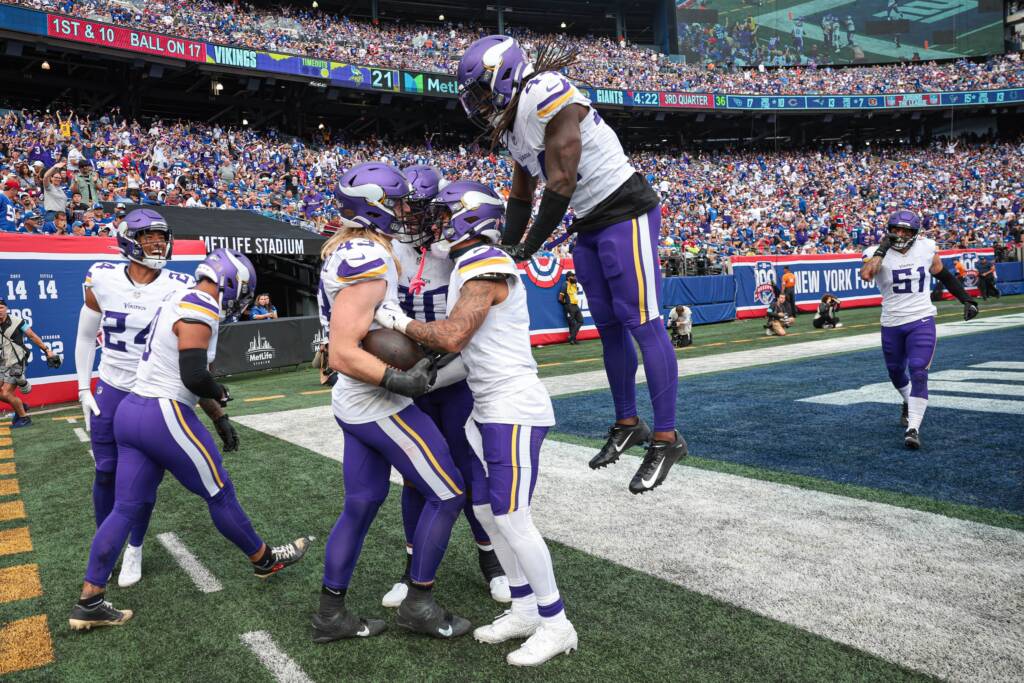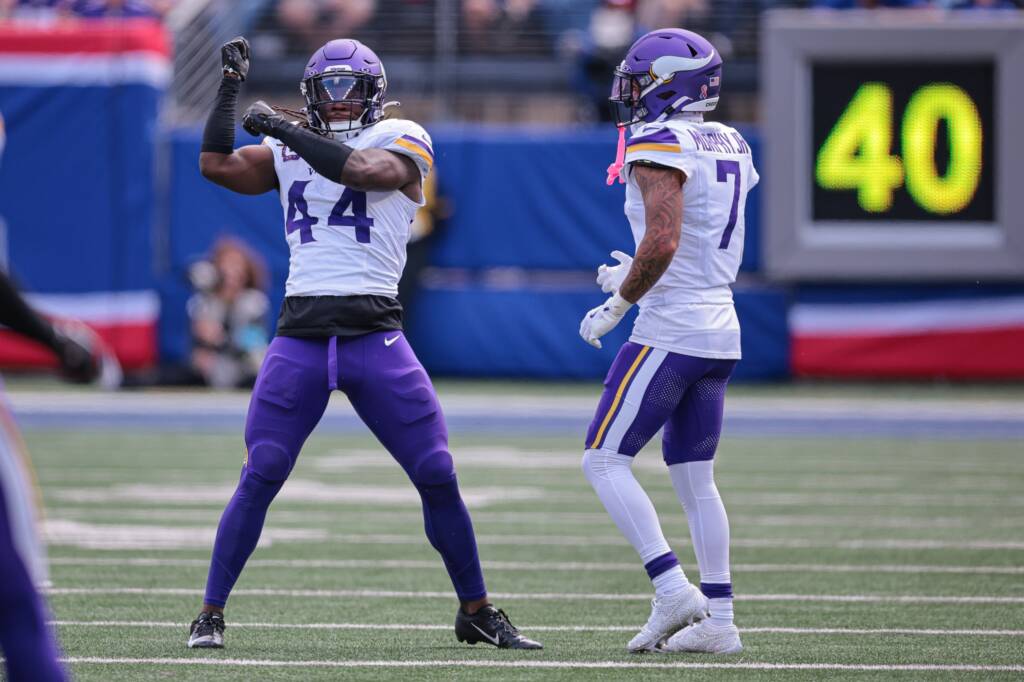The celebration was on after the Minnesota Vikings returned to the locker room after their Week 1 win over the New York Giants. The players acted like “W” was the letter of the day. Kevin O’Connell gave one of his patented post-game speeches. He handed out game balls like Halloween candy. The memory of a 7-10 season faded into a mirror.
Sam Darnold, Aaron Jones, and players were the main focus, and general manager Kwesi Adofo-Mensah hung out in the back of the locker room. He didn’t get one of O’Connell’s famous game balls, but he deserved one because the Vikings also earned a win off the field thanks to a little something called Kwesinomics.
The NFL is a more numbers-oriented game than it was in the past. Sure, the cliché of it being a game of inches still applies (ask Isaiah Likely), and the players on the field determine wins and losses. But Adofo-Mensah’s offseason was filled with pivotal decisions that gave the Vikings smaller victories in Week 1.
It started on defense, where Brian Flores cooked up a masterful game plan. The secondary did its job, locking down explosive rookie Malik Nabers, and the defensive line did just enough to handcuff New York’s rushing attack. However, the biggest impact may have been with the edge rushers after Danielle Hunter signed with the Houston Texans.
Some worried that Hunter’s departure would weaken Minnesota’s pass rush. He was the fastest player in NFL history to get to 50 sacks and racked up a team-high 16.5 sacks a year ago. If not for a pair of seasons lost to injury, Hunter may be considered one of the best pass-rushers in the league.
The Texans thought enough of Hunter to give him a two-year, $49 million contract in free agency, potentially leaving Minnesota’s pass rush in shambles. That is until the game started on Sunday. The Vikings sacked Jones five times, and Hunter’s replacements made the difference.
Jonathan Greenard ($19 million) had five pressures to make a silent impact. Rookie Dallas Turner ($3.9 million) earned his first NFL sack. Then there was Andrew Van Ginkel ($10 million), whose blonde hair flowed all over the field with a sack and a pick-six. The pass rush was so good even Patrick Jones II ($1.2 million) joined in with a pair of sacks.
The total cost of $34.1 million is more than the $24.5 million the Texans are paying Hunter. Still, the Vikings got four impact players for a little more than it would have cost to re-sign Hunter last spring.
However, while Kwesi’s decision to let Hunter go helped the defense, it was complemented by his biggest decision of the offseason.
Many thought the Vikings would crumble if Kirk Cousins left Minnesota. Cousins’ career stats with the Vikings – which include four years over 4,000 yards passing and three years over 30 touchdowns – are right next to Adam Thielen’s birthplace on the Minnesota citizenship test. After nine games of rotating through Josh Dobbs, Nick Mullens, and Jaren Hall, it wasn’t a given that the Vikings would be competent under center.
But hours after the Atlanta Falcons gave Cousins a four-year, $180 million contract ($45 million AAV), the Vikings found his short-term replacement in Sam Darnold.
Nobody will mistake Darnold as a long-term answer for the franchise, especially when they drafted J.J. McCarthy last April. Still, Darnold did exactly what O’Connell wanted him to do on Sunday.
Darnold hunted for big plays downfield. He got the ball to Justin Jefferson but also found his other receivers, dropping a beautiful dime to Jalen Nailor for a 21-yard touchdown. Darnold trusted the system and ran it to the best of his ability, throwing for 208 yards, a pair of touchdowns, and an interception.
While he didn’t look like Peyton Manning or Tom Brady, he also didn’t look like the version of himself that used to play in MetLife Stadium. He trusted the system, got the ball to his weapons, and made good decisions — exactly what O’Connell wants out of his quarterbacks.
Meanwhile, the Cousins era got off to an auspicious but familiar start in Atlanta. A strong Pittsburgh Steelers defense swarmed him, and he threw his first interception in the first quarter. Vikings fans knew what was coming next as Cousins looked tentative and unwilling to trust his new teammates the rest of the afternoon.
With the game on the line, Cousins threw another back-breaking interception. When he got one final chance to tie the game down 18-10, he threw a seven-yard out route with no time-outs remaining before T.J. Watt sacked him to end the game.
It’s a lot like what Vikings fans have experienced over the past six years: a team with a highly-paid quarterback that needed another piece or two to complete the puzzle, but salary cap restraints forced the front office to play Whack-A-Mole.
With $35 million in cap savings, Adofo-Mensah wasn’t only able to get the pieces needed at edge rusher, but he also used that money to sign Stephon Gilmore when the Vikings needed a cornerback last month. Kwesinomics will become a bigger thing next offseason when the Vikings have $66.5 million in cap space to fix some of the other holes on the roster.
Kwesinomics doesn’t apply to all players demanding big contracts; you must sign your cornerstones like Justin Jefferson and Christian Darrisaw. But knowing when to throw in the towel is the difference between building a contender and one that perenially hovers around .500.
For one week, Kwesinomics worked in Minnesota’s favor. And it could lead the Vikings in a direction they haven’t been in for a long time.

